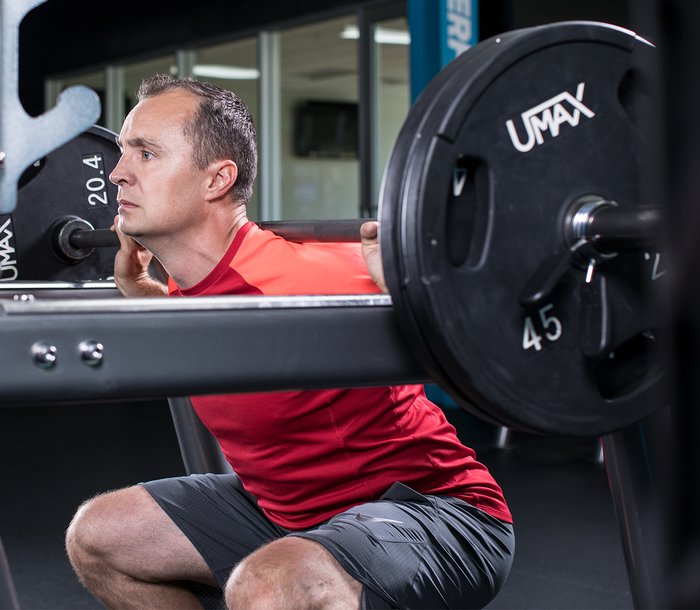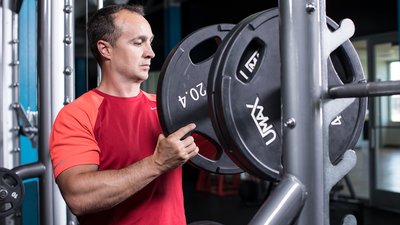Q: I've noticed that as lifters get older, they often seem to have more trouble with the squat than with the bench or deadlift. Is there a way to keep squatting heavy as I get older, or am I simply asking for problems?
I've noticed the same thing. I've also noticed that as competitive powerlifters age—especially men—they tend to drift away from the traditional three-lift competition and veer toward doing push-pull (deadlift and bench press only), or even bench-only meets.
This doesn't have to be the case for you, but yes, there are reasons why older lifters should approach heavy, low-rep back squatting to parallel or below with some skepticism. Let's break down the reasons, and give you lots of options to work with.
What you need to know about your knees
First, compared to sturdier joints like the hip, knees tend to be a bit more fragile and prone to injury as many of us age. Of course, your situation may vary, but there are a few structural reasons for this tendency.
For starters, the hip is a deep, ball-and-socket joint, supported and protected by its very design, and the relatively large amount of muscle that surrounds it. The knee, by comparison, is a superficially-located hinge joint, and it depends mostly on connective tissue for its support. Connective tissues are often poorly vascularized—meaning, they have little blood flow—to start with, and their blood supply becomes even more limited as we age. This makes these tissues generally more prone to injury, as compared to muscle or even bone.
Second, your personal lever lengths may simply make you better or worse at squatting. The longer your femurs (thigh bones) are, relative to your total height, the more forces they impart to the knee joint during the squat.

Think of it this way: Imagine trying to turn a very tight bolt with a 12-inch long wrench. It's not budging, so you take out your wrench that has a 24-inch handle. Suddenly, the bolt gives way almost effortlessly. With that visual in mind, next think of the wrench handle as your femur, and the bolt as your knee. Now you can appreciate the impact of a long femur on the forces that are transmitted to the knee. It's also worth noting that the longer your femurs are, the lower you'll need to squat in order to reach any particular depth standard.
Are you a powerlifter? Then depth matters. But if you're a generalist—and I think it's a key strategy for most older lifters to embrace generalized training—then squat the way that makes the most sense.
Let's talk about depth
A final reason your knees may not like heavy back squats is that the depth standard used in powerlifting—and in Internet commenting—isn't the ideal strategy for every lifter. The older you get, the less likely your knees will like the combo of depth and heavy weights.
Look, if you're not a powerlifter, ignore all the lifting dogma about squat depth. While deeper is generally better—as long as you can maintain acceptable posture and body mechanics—smart coaches know that optimal squat depth is different for each individual. Personally, I like to have lifters squat to a box as a way of encouraging sound mechanics, to find their ideal depth, and also to ensure that they meet that depth consistently.
Start with a box that you know you can reach without pain, and with good form. What's good form? Three things:
- You maintain a neutral lumbar posture.
- Your feet stay flat on the floor.
- Your knees track directly over your feet rather than caving inward.
Also, remember the squat used to be called a "deep knee bend" back in the day. What I mean by this is that if you're not bending your knees much, and your back is parallel to the floor when you touch the box, you're not really doing a squat.
Once you can successfully manage a given box, work on gradually progressing to lower boxes over time, but carefully monitor your form and watch for pain and dysfunction. Personally, I normally squat to a 14-inch box, which places me slightly higher than the "thighs parallel" powerlifting standard (old surgical scar tissue in my right knee prevents a deeper position).
Think squats, not squat
Remember, the barbell back squat is only one of many ways to squat, and it just might not be the best variant for you. And, even if it is, you should use a handful of squat variants in your overall training. In my Bodybuilding.com BodyFit Elite program Total-Body Strong, you perform squats three days a week, but not the same type each day. For example, you could do back squats or box squats one day, goblet squats or front squats another, and a single-leg squat variation on a third. The leg press and hack squat can definitely be helpful to keep in the mix as well.

Like all worthwhile exercises, the squat is almost infinitely modifiable. You can load it on the back, in front, in the hands, or even in the crooks of the elbows, to name just a few options. There are also all sorts of specialty bars out there that often make squatting more palatable—the safety squat and buffalo bar quickly come to mind.
It's also worth mentioning that you have multiple ways of progressing all of these squat variations other than simply adding more weight. For example, you can slow down or otherwise alter the tempo, or squat against band or chain resistance.
Why are you squatting?
As a parting thought, I urge you to do some introspection about what is driving you to squat in the first place. If you're squatting because you want bigger or stronger leg muscles, there are many exercises that will get you there. If you just like to squat or simply take pride in your ability to do it, I totally get that. But don't stubbornly insist in doing it through chronic pain in the knee or elsewhere.
You want to still be lifting in 20 years after all, right? Then act that way now!

